To rank in Google, you need to understand the intent behind your target search term, and create content that satisfies it. Therefore if you want to turn content marketing into revenue, you need to start close to the bottom of the funnel.

Luckily for us, there are already consumers out there who are in the final stages of their decision making progress. Rather than creating ‘how to’ and ‘what is’ informational content with no opportunity to mention your product, we can identify search terms that indicate a user our technical SEO consultants has identify search terms that indicate a user.
In this post, you’ll learn how to find these keywords for your niche. We’ll cover:
- What is search intent?
- Why focus on high intent keywords
- How to find high intent keywords
- 5 real-world examples of high intent content
- What to do once you start getting high intent traffic
Let’s get into it!
What is search intent?
Search intent is a term we use in SEO for understanding the purpose of a search. The reason why someone is on a search engine, and what they would like to find.
If you don’t get this right, your content won’t rank in Google. On-page optimisation, backlinks & other things are all relevant ranking factors, but if you get the intent wrong, you simply will not rank. Google published a document on this a few years back.
Understanding what the user is looking for is a crucial step that is often overlooked. Checking search intent is something you can do relatively quickly, and it should definitely be on your to-do list before investing resources into creating SEO strategy. To ensure your content aligns with search intent, you can check it with the help of a keyword suggestion tool on SE Ranking. By using this tool, you can analyze relevant keywords and phrases related to a specific search query, gaining valuable insights into the intent behind it. Incorporating these insights into your content can greatly enhance its relevance and increase the likelihood of ranking higher in search results.
To illustrate, here’s one quick example. We’ll look at more later in this article.
Let’s say you want to rank for ‘fish oil’.
What do you think this person is looking for? To buy fish oil? To learn about it? Something else?
In this case, it’s informational — to find out about the benefits of fish oil. There are multiple possible intents, but this is the dominant one.
Another example of an informational search intent is a user typing “cell phone stores near me.” This user wants to find the mobile phone businesses nearest to them, and the keywords can be relevant to the brands offering what the user is looking for.
Google has worked hard to improve how well the algorithm understands search intent, and these days it’s usually pretty spot on. Other than a few outliers (low volume niche topics), you can figure out search intent quickly by simply looking at the search results.
In order to rank for your desired keywords, your content needs to match the search intent.
Why focus on high intent keywords?
Search intent could be:
- Informational — e.g how to, what is
- Navigational — e.g. google drive (instead of typing in the URL)
- Transactional — e.g. buy xyz, abc price
- Commercial — e.g. best xyz, abc review
Here’s some examples:
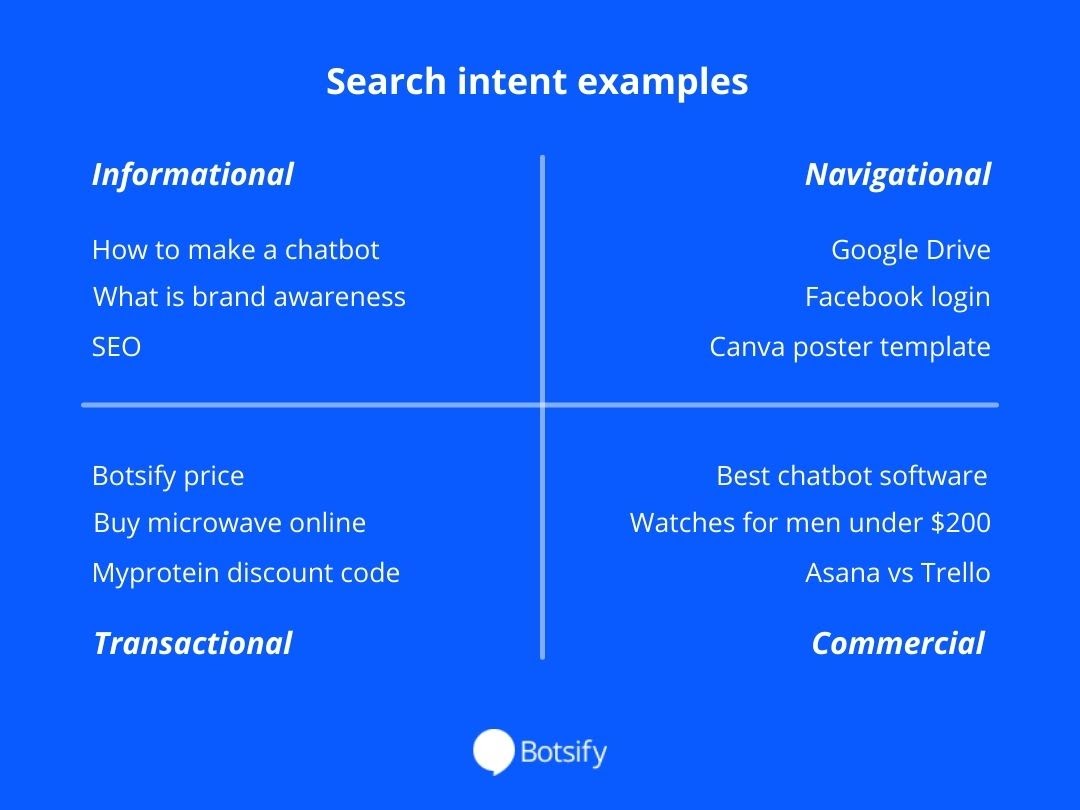
For now, let’s focus on the latter two.
When we use the term ‘high intent keyword’, it’s referring to transactional and commercial intent. People who are in ‘buying mode’, or very close to it.
The reason why many content marketers & SEOs want to focus here is because this is the bottom of the funnel. By this point, users know what their problem is, and they most likely know some or all of the solutions available. Now they just need to make their final decision.
Once you start going further up the funnel to informational intent, there’s often no clear route to generating revenue from the content. If someone searches ‘what is a chatbot’, for example, they’re almost certainly not ready to buy a chatbot software.
That person needs educating and nurturing over a lengthy period to become a customer. In fact, they might never become customers. It could be a college student, or someone who is just curious.
So rather than putting in that effort to generate thousands of visits and attempt to nurture leads over time, marketers can simply start at the bottom of the funnel.
How to find high intent keywords
Once you understand what a high intent keyword is, the next step is to find some that are relevant to your business.
To start with, you’ll need a keyword research tool. There’s a bunch of different ones out there, and most offer a free (or low-cost) way to give them a whirl.
Personally, I use Ahrefs together with KWFinder by Mangools. I’ve explained the reasons for that in a separate Mangools vs Ahrefs comparison post. In a nutshell though, it’s because KWFinder has more accurate search volumes & great related keyword suggestions (but doesn’t replace other functions of Ahrefs).
Now they will appear high up in SERPs whenever anyone is looking for tools like Trello, Semrush & SE Ranking. after “pitching their product at the top of the list”, the process is fundamentally the same.
I’ll show you two primary methods here.
1. Research competitor rankings
If you don’t know where to start, try thinking of a competitor. You can use SEO software like Ahrefs (my preference) to identify which of their pages generate traffic, and which keywords those pages rank for. This is a great way to reverse engineer their SEO & content strategy.
After that, all you need to do is filter through and find the high intent keywords.
Here’s how to do it.
Start by going to Ahrefs Site Explorer, and drop in your competitor’s URL.

If it’s a small site, you can go to the ‘organic keywords’ or ‘top pages’ reports, and dig through manually for opportunities. On a big site like this, however, you’ll want to apply filters.

In the ‘organic keywords’ report, add modifier keywords that infer high intent. You can try modifiers such as:
- Best
- Top
- Alternative
- Vs
- Comparison
- Review
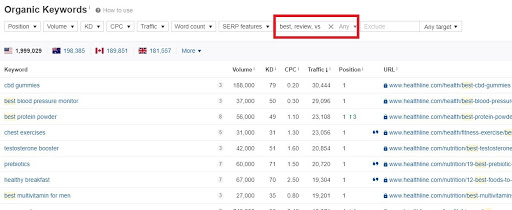
From there, it’s a manual process to sift through and identify the best opportunities by considering search volumes & keyword difficulties. Repeat this with multiple competitors in your niche, and make a shortlist of opportunities.
Another alternative is to use rank tracking software. This not only offers keyword research features but also gives you insights into how well your pages are ranking in the search engines.
2. Get suggestions from a ‘seed’ keyword
Your other option is to start by thinking of a broader keyword, and let the software generate suggestions for you.
If you’re working with large volumes of potential keywords, the trick here is to use phrase matches with ‘high intent modifiers’.
Here’s an example. Let’s say we’re a project management software, looking for keywords related to ‘project management’. I would head to Ahrefs Keyword Explorer, add my keyword, then switch to phrase match.
Next, add a filter to include certain modifiers. Here, I’ve used ‘best’, ‘tools’, and ‘software’ as an example:
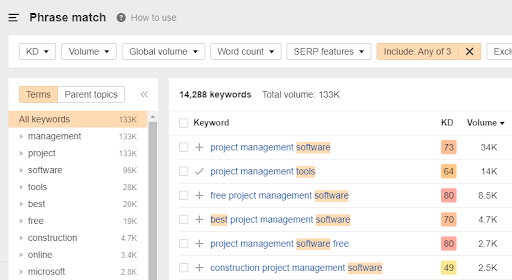
The results give me volumes & difficulty for some high intent keywords such as ‘best project management software’, as well as new ideas like ‘construction project management software’.
You can also try this by using a competitor brand. I’ll use Trello as an example. This is the same process: Ahrefs Keyword Explorer → phrase match → add modifiers. I’ve used ‘ Trello alternatives’ and ‘vs’ to find comparison keywords.
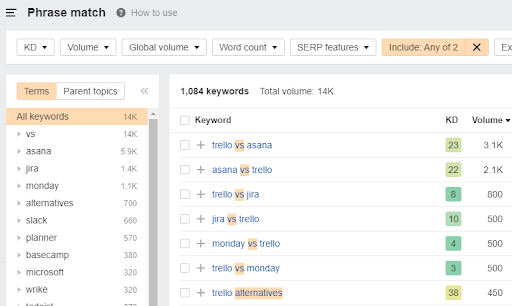
I recommend that you use both of these methods, and make a shortlist of keywords you could pursue. Then, start prioritising them based on criteria like:
- Average search volumes
- Keyword difficulty
- Potential conversions (if you ranked #1)
- Your production capacity
That will come together to form a content strategy for high intent keywords.
For instance, if you are an invoice generator website you should look into keywords like “creating invoices“, “invoice generator”, and “online invoice”. This would help you make better keyword with the help of seed keyword.
5 real-world examples of high intent content for inspiration
Here’s 5 different examples of high intent content and the keywords they’re targeting. I’ve included a range of examples from saas, to e-commerce, to affiliate sites for a broader view.
1. ‘Best email marketing services’ by GetResponse
When someone searches for ‘best’ anything, the intent is usually a list of options. This is true with physical products (e.g. best smartphone under $500), and with digital marketing services, like in this example.
So if the intent requires a list, you won’t be able to rank your product or service landing page. The solution, then, is to simply create a listicle like everyone else, and add your own product at the top.
These convert really well, and it’s a great way to get in front of your ideal customer before they’ve heard of your brand.
Here, GetResponse has listed out popular email marketing tools with key features & pricing mentioned, and a handy comparison table at the end.

2. Piktochart’s infographic templates
If someone searches for a template, the person knows precisely what they’re looking for, and they want to get started quickly. If your product can enable that & provide the solution, you can expect some high conversion & activation rates by providing immediate value.
Piktochart are doing this with template libraries for infographics, and other formats (reports, presentations, etc.). Lots of saas brands will be motivated to create templates anyway for their existing users and for product activation purposes. If you can roll those out onto public facing web pages and rank them, you’re in for some high intent traffic.
On this page, Piktochart present their infographic templates, and make them easily filterable (e.g. comparison, process, timeline infographics).
Clicking any of them links to a preview, with a CTA to start editing it using Piktochart.
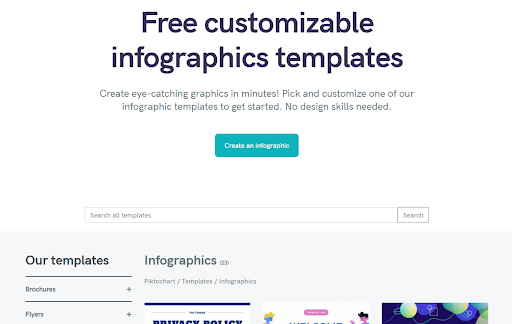
3. ‘Trello alternatives’ by Toggl Plan
‘Alternatives’ is a great high intent keyword to pursue. Here, you can assume that the searcher knows their problem, and even knows some of the solutions available. This is a big opportunity for challenger brands to leverage the brand awareness of a market leader.
This is commonly seen in saas and e-commerce. Trello has enormous brand awareness, but isn’t a perfect fit for everyone. As such, there are thousands of people searching for similar alternatives. Toggl Plan satisfied that search intent, and started by pitching their product at the top of the list.
With this type of content, it’s a good idea to add additional criteria or features by which alternatives were selected. One person’s reason for seeking an alternative would be different to another’s.
Toggl has also made for a great reading experience here by adding a summary table near the top, acting as a ‘tl;dr’ to give an answer at a glance.
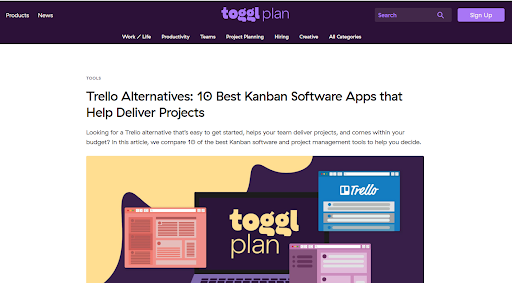
4. Affiliate comparison: Buck 110 vs 112
This small niche affiliate site is a good example of product x vs product y search intent. Here, Knivesadvisor has identified a keyword with search demand and low difficulty:

And then created content to satisfy the search intent. They identify the key differences, provide a short summary, then go into the details. Which knife is better for which use case.
The CTA here is to click on an affiliate link to check prices, through which the site will earn a commission if a product is purchased.
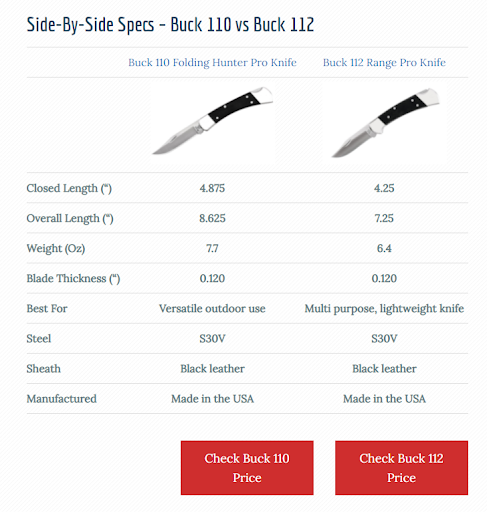
5. Affiliate product review: Pillow Cube Review
Now on the other end of the affiliate spectrum, The Wirecutter by NYTimes is one of the biggest & well-known affiliate sites covering a broad range of niches.
Product reviews are another common affiliate search term. You’ll often find big sites like this, or small content creators who are keen to rank for various review search terms for popular products in their niche.
People searching for ‘xyz review’ know their problem, are aware of a potential solution, and are in the last step of confirming their decision. Here, they’ve taken advantage of an explosion in popularity for this product:
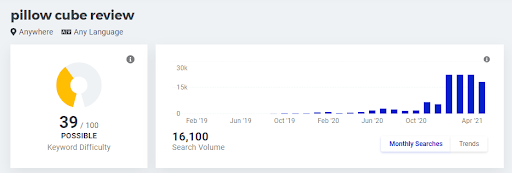
They’ve then identified the product’s target market (side sleepers), provided an expert opinion (in this case, against the product), and recommended some alternative solutions.

So you’ve got high intent traffic. What’s next?
Generating the traffic, even when it is high intent, is still only half the battle.
The next step is to convert your traffic into a meaningful action that can ultimately lead to revenue. That’s where conversion rate optimization (CRO) comes in.
Since we’re talking about high intent keywords, you’ll have a much easier job when it comes to CRO. Instead of trying to have someone download a lead magnet or join an email list, you can simply skip straight to the more aggressive call-to-actions (CTAs), e.g:
- Get started for free
- Sign up for a free trial
- Add to basket
- Request a demo
With that in mind, here are 3 proven CRO tactics you can use to convert your high intent traffic.
1. Use a chatbot
Used correctly, chatbots on landing pages & blog articles can have a significant positive impact on conversion rates.
Chatbots simply allow a user to get the instant answers & information that they’re looking for.
A 2017 study found that 69% of consumers who were asked said they would prefer to interact with a chatbot rather than calling or sending an email due to the instant answers.
Setting up a chatbot can also help you to learn from the interactions. What are people asking? Analyzing user queries might lead you to figure out what’s missing from your landing page, leading to a permanent uplift in conversion rate.
2. Reduce friction
What are the potential points of friction a user might encounter on your landing page or article? Here are some things to think about:
- How much information are you asking for? For example, on a demo request form, do you really need company name, company size, and phone number? Or can you use an enrichment tool like Clearbit to save the user some steps
- For digital products & services, do you require a credit card to sign up for a trial? Consider if it’s necessary. What is the impact on your sign up quality & activation if you remove it?
- Make sure your load speed and user experience is slick. Other than load speed being a ranking factor in Google, it’s also important for CRO. In short, the faster the page is, the less visitors you’re likely to lose:
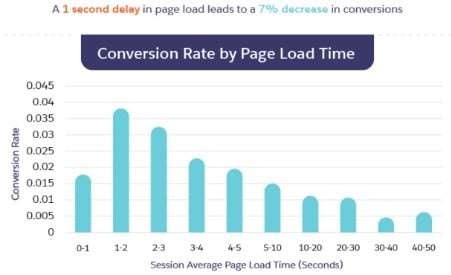
3. Run an A/B test
A/B testing (or split testing) will let you compare two variants of the same page to see which converts better. Common things to test might be CTA text and positions, adding testimonials or social proof, using videos vs gifs or images, and so on.
I do recommend you get familiar with a tool like Google Optimize or Optimizely to test your CRO initiatives. That being said, be careful. Don’t fall into the trap of running tests for the sake of it.
Many tests won’t lead to a statistically significant outcome, especially if you’re working with smaller volumes of traffic.
Take this case by case, and focus on changes above-the-fold to find the biggest impact.
Wrapping up
In a nutshell, checking search intent is a very simple step, yet omitting it will prevent any chance of success. All your other SEO strategies, link building tactics & other promotional initiatives will all be redundant when search intent is mismatched.
Get yourself accustomed with keyword research software, start analyzing the opportunities in your niche, and start generating some high intent traffic!

